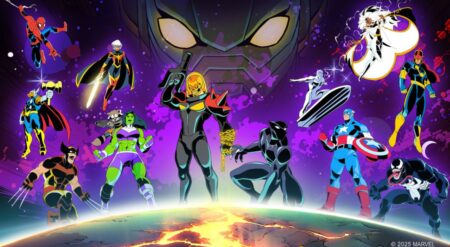Killing Floor 3 delivers the kind of brutal, co-op chaos that has defined the franchise since its early days. Set in a dystopian 2091, it pits a team of Nightfall operatives against relentless waves of Zeds in gory, over-the-top arenas. The formula is familiar: hold the line, survive each wave, and gear up in between.
This time around, the series tightens its shooting mechanics and adds layers of customization, but stops short of transforming its identity. For long-time fans, the game offers refined thrills. For newcomers, it may feel like a remix of genre staples that others already do with more daring.
Developed by Tripwire Interactive, Killing Floor 3 shows the studio doubling down on the elements that made the franchise a cult favorite: punchy gunplay, grotesque enemy design, and high-octane co-op action. The experience feels finely tuned and grounded in what the developers do best, even if it doesn’t break from tradition. What’s more encouraging is their public commitment to supporting the game long-term.
The core structure remains intact. In Killing Floor 3, players fight through escalating waves of increasingly dangerous Zeds, collecting Dosh to spend on weapons, armor, and ammo at the end-of-wave trader pod. Matches build toward a final boss battle, with brief reprieves between bouts of escalating chaos. A few wrinkles attempt to freshen the loop.
Killing Floor 3 sticks to a familiar formula for co-op shooters.

Mutators occasionally shake up the rhythm by altering enemy behavior or introducing elemental twists. Movement feels more responsive now, with slides and vaults offering better options for evasion. Zed Time, the slow-motion combat feature, remains a highlight, giving shootouts a cinematic flair.
Gunplay hits hard. Each weapon behaves with distinct feedback, from the chunky thud of a shotgun blast to the precision of a scoped rifle. The updated gore system, M.E.A.T. 2.0, adds a visceral layer to every encounter. Blood soaks the environment, limbs fly, and heads burst with gruesome satisfaction.
Enemy types are familiar but redesigned with more menace. Fleshpounds, Sirens, Crawlers, all return with more intelligent behavior and more punishing attacks. Combat is chaotic but rarely unfair, rewarding both twitch reflexes and tactical coordination.
The addition of Ultimate abilities and gadgets for each class injects new strategic elements. Whether deploying an auto-targeting drone or igniting a group of Zeds with incendiary rounds, these tools offer high-impact moments that break up the monotony. The gunplay, paired with a relentless metal soundtrack, ensures each wave feels like a combat gauntlet dialed to maximum.
Flexibility between classes helps deal with the lack of personalization for players in Killing Floor 3.

Killing Floor 3‘s six classes—Commando, Sharpshooter, Firebug, Medic, Engineer, and Ninja—offer distinct playstyles. Each class comes with its own skill tree, Ultimate ability, and weapon set. While players start with specific class characters, a future update will allow swapping character skins across classes. This flexibility should help address early frustrations about personalization.
The skill tree system replaces the older perk-based model with a more modular, layered progression. Players earn Proficiency Points to unlock active and passive perks, often choosing between branching upgrades. The build options add variety, but leveling remains a grind, especially with six classes to explore. Each one can take upwards of 20 hours to fully upgrade.
Weapon modding introduces a layer of customization unseen in prior entries. Every gun has multiple mod slots, allowing for changes to fire type, ammo behavior, and attachments. Modded weapons can be crafted and saved as loadouts, then purchased mid-match if funds allow.
The system encourages experimentation but also introduces grind-heavy material requirements. Biosteel, the main resource for crafting, drops sparingly. Crafting duplicate mods for multiple weapons adds to the slog, even if the payoff is worth the time investment.
Running on Unreal 5, Killing Floor 3’s visual identity is sound but often lacks distinction.

Loadout freedom is one of the sequel’s best changes. Players are no longer restricted to class-specific weapons. A Sharpshooter can now carry a support shotgun without penalty, allowing for more dynamic team compositions. The overall structure encourages creativity, while still rewarding specialization through class bonuses and synergies.
Built on Unreal Engine 5, Killing Floor 3 leans into gritty industrial environments drenched in shadows and blood. The gore system is its standout visual feature, but map variety lags behind. Most of the eight launch arenas blur together in tone—dark corridors, broken streets, abandoned labs. Functionally sound, but lacking visual distinction.
Audio design is another high point. The weapon sounds are punchy, enemy screeches are easy to identify in the chaos, and the soundtrack propels the action forward with metal anthems that match the carnage on screen. Voice lines between characters add some levity, reinforcing the series’ B-movie tone.
Tripwire Interactive has laid out a detailed Year 1 Roadmap that signals their commitment to keeping Killing Floor 3 alive with fresh content. The first major update, the Rearmament Update, introduces performance improvements, new weapons and mods, and a long-requested decoupling of perks and specialist characters. Season 2 adds a new map set in a prison, a new Zed, and the return of fan-favorite specialist DJ Scully.
Killing Floor 3 isn’t perfect, but Tripwire’s plan to continue support is promising.

Looking ahead to 2026, players can expect even more with Season 3, introducing a new Research Base map, a new enemy, and additional assignments. Season 4 follows up with the debut of the Gunslinger perk, a new boss, and continued expansion to the campaign and mod ecosystem. Ongoing improvements include new difficulty settings, modding support, text chat, music collectibles, and more.
This roadmap paints a promising picture. Not only is the game supported with consistent content drops, but there’s a clear focus on tuning performance, quality-of-life fixes, and adding features that bring the game closer to modern co-op shooter expectations.
Ultimately, Killing Floor 3 delivers satisfying co-op carnage and smart upgrades, but leans on familiar ground while setting the stage for stronger updates ahead. Those seeking innovation or narrative complexity will find more engaging options elsewhere. But for players who enjoy wave-based co-op shooters built around crunchy gunplay and class synergy, it delivers precisely what it promises. It’s a blood-soaked power fantasy that knows what it is and doesn’t pretend to be anything more.
Killing Floor 3 is available now on PC via Steam.
Killing Floor 3
-
Rating - 7/107/10
TL;DR
Killing Floor 3 delivers satisfying co-op carnage and smart upgrades, but leans on familiar ground while setting the stage for stronger updates ahead. Those seeking innovation or narrative complexity will find more engaging options elsewhere. But for players who enjoy wave-based co-op shooters… it delivers precisely what it promises.







